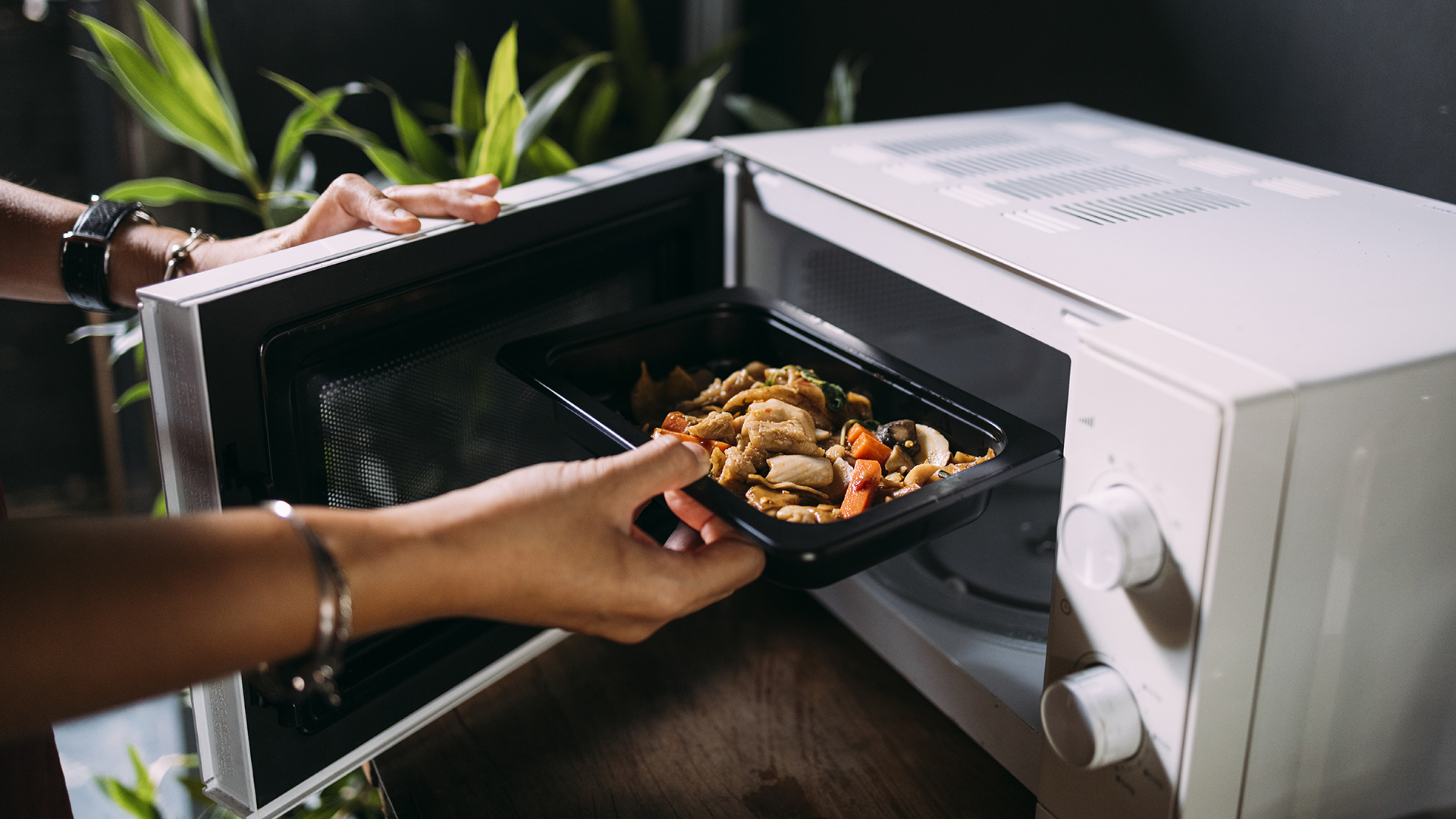Microwave ovens are great time-savers, and if you own one of the best compact microwaves, they are also really space-saving.
The best microwaves are also energy efficient, and as a bonus, they require far less washing up than other cooking methods.
"Microwaving food is an excellent way to cook—it is quick and convenient, does not alter the nutritional quality of the food, and uses relatively little energy," Dr. Deborah Lee, from Dr Fox Online Pharmacy, told Top Ten Reviews.
However, a common question is: Can microwaves kill bacteria? I consulted the experts to find out.
Can microwaves kill bacteria?
Here's the thing: Microwaves don't actually kill bacteria, but they can kill the bacteria in foods when heated to a safe internal temperature.
And now for the science bit: food scientist Dr. Bryan Quoc Le told Top Ten Reviews: "The microwave irradiation from the appliance can rapidly heat the internal water of bacteria, causing their proteins to denature and the water to vaporize rapidly.
"While these effects are not uniform and are shielded by the water of the food itself, occasionally there are heat spots in the food where the bacteria are fully killed if the temperature reaches 212°F, boiling the bacteria from within."

Having worked for many years in the UK for the NHS (National Health Service) as a lead clinician, Dr. Deborah Lee now works as a health and medical writer for Dr Fox Online Pharmacy.
To reach a safe temperature, the microwave needs to get hot enough to kill the bacteria present in food. But remember that food that is not heated for long enough or to the correct temperature can still contain bacteria.
Foods can be cooked unevenly because of irregular shapes or differences in thickness. Despite using a turntable (to distribute the heat), microwaves can often leave cold spots in food where bacteria can live.
Dr. Lee adds, "Microwaves have been found to kill bacteria even at lower temperatures by destroying the bacterial cell wall. However, note that improperly cooked microwaved food is a common cause of food poisoning. There may be ‘cold spots’ in the foods during cooking. For example, the microwave can only penetrate the food to a depth of 2cm. So, the microwave cooks the food from the outside first and the middle position last."
"This is why food needs to be carefully heated in a microwave, regularly stopping and stirring and not eating until it is piping hot all the way through. Ideally, use a thermometer, and the food should reach 167°F for at least 30 seconds," she says.
To avoid food cooking unevenly in your microwave oven:
- Follow package instructions, rotate, and (if the instructions call for it) stir foods during the cooking process.
- Use a food thermometer to check the temperature of microwaved foods in different spots.
- Before you eat a microwave meal, make sure it is thoroughly cooked and piping hot.
- Observe any standing times—this helps eliminate hotspots, evens out the temperature, and lets the food cool down sufficiently so you don't burn yourself.

Dr. Bryan Quoc Le is a food scientist, food industry consultant and author of the book 150 Food Science Questions Answered. He consults for companies and startups in the food and beverage industry with clients including Blue Diamond Growers, Little Caesars Pizza and Black Sheep Foods.
How long does it take to kill bacteria in a microwave?
According to the Centers for Disease Control and Prevention (CDC), home microwaves (2.45 GHz) can kill some types of viruses and bacteria within 60 seconds to five minutes. However, more disinfection occurs with higher-powered microwaves.
What kind of bacteria typically lives in a microwave?
Don't be alarmed. Researchers found that your microwave oven has its own microbiome, many of which are totally harmless.
"Several bacteria live in the microwave, primarily microorganisms present on human skin," says Dr. Quoc Le. "Bacteria species that dominate microwave microbiomes include Proteobacteria, Firmicutes, Actinobacteria, and Bacteroidetes, which are very similar to the ones found on our skin.
"Many of these bacteria are harmless, and microwaves rarely pose a food safety risk."
However, Dr. Lee warns: "E. coli and salmonella have both been found in microwaves. In fact, in one study, the microwave was referred to as a ‘microbial hotspot.’ Raw meat is a potent source of these bacteria.
"Plus, food splatters in the microwave and can end up in the crevices and under the rotating plate. Bacteria are frequently present on the handle, which is grasped repeatedly."
How can you tell when your microwave is unsafe due to bacteria?
Dr. Quoc Le says the microwave should not contain clear spots of moist food, as these can be reservoirs for microorganisms that cause food-borne illness. Certainly, there should not be visible signs of mold."
Dr. Lee adds, "Another sign is when you switch it on, the kitchen quickly fills with a horrible, perhaps burning smell."
How to avoid bacteria in your microwave
You need to clean your microwave to avoid getting bacteria in it.
"Microwaves should be regularly cleaned, at the very least once per month, and as often as once per week to remove major food sources splattered around," says Dr. Quoc Le.
"Clean it with a disinfectant, such as bleach or hydrogen peroxide, to greatly reduce the level of microorganisms in the microwave."
"A more natural way to clean the microwave is to put a bowl of water and vinegar in the microwave and put it on for two minutes," says Dr. Lee. "Then remove and wipe out the inside with a damp cloth. It’s not recommended to spray kitchen cleaner inside the microwave directly as it can get into the vents and could get mixed with your food."
"You can also add lemon juice to the vinegar and water cleaning solution and microwave for two minutes, but keep the door shut and allow the steam inside it to percolate for 15 minutes.
"If it's still dirty, paste it with baking soda and water and lather it onto the affected areas. Any sticky residue can be scraped off with a plastic implement such as an old credit card."
Verdict
The heat microwaves produce can kill bacteria and other pathogens when they get to a certain temperature. However, the effectiveness of this process largely depends on how the microwave is used. Microwaves create heat by creating electromagnetic waves that excite water molecules in food. As a result, bacteria and other microorganisms die.
It's important to stir or rotate the food halfway through cooking to ensure it's heated evenly and to a safe temperature. Microwaves heat food unevenly, so it can leave "cold spots" where bacteria can live. By doing so, the heat gets distributed evenly, and all food reaches a safe temperature.
Food should be heated to 165 degrees Fahrenheit for most bacteria to die. Using a food thermometer can help ensure that the food reaches this temperature. In addition to heating food to a safe temperature, remember that some foods are more prone to bacterial contamination than others.
Bacteria can easily grow on foods with high moisture, like meats and dairy products. To ensure their safety, it's important to store these foods properly and cook them thoroughly.

